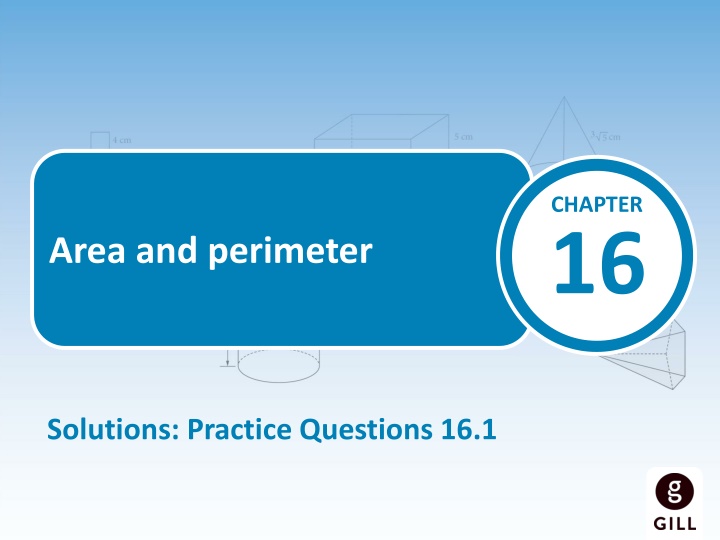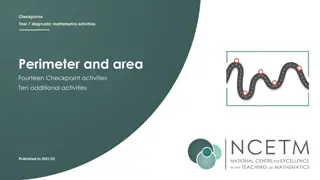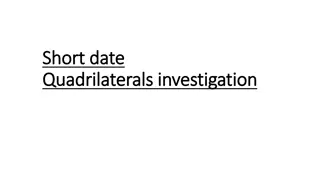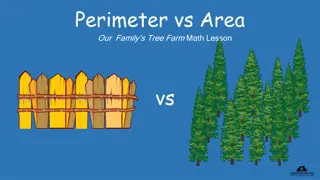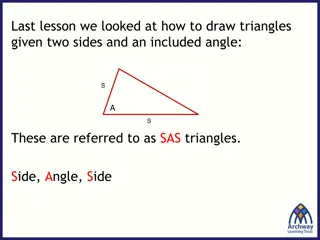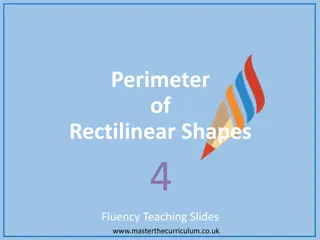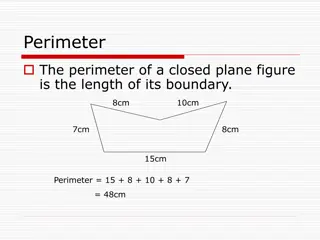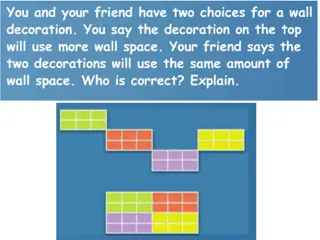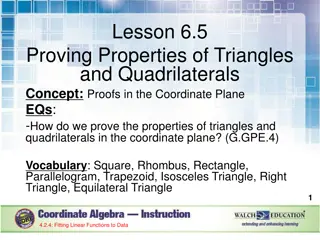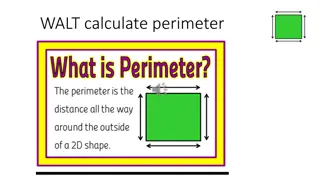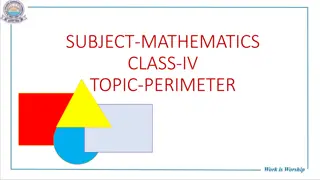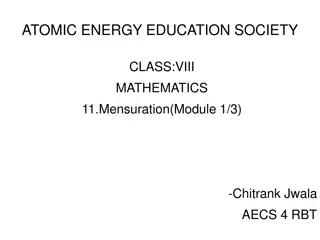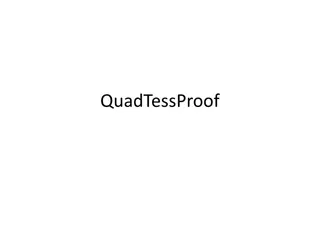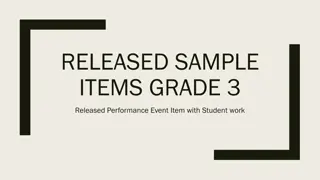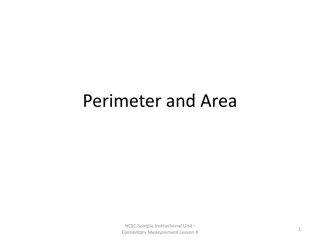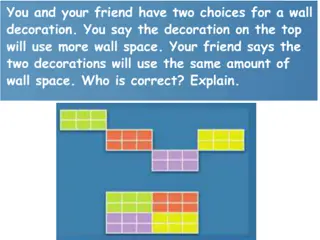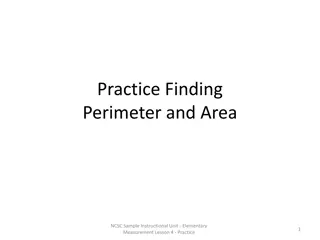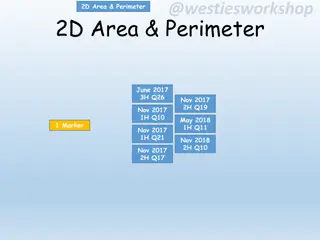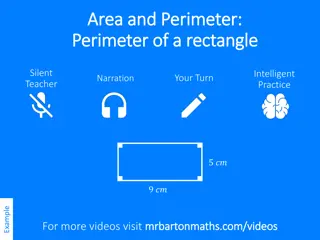Area and Perimeter Practice Questions: Quadrilaterals and Triangles
Various practice questions related to finding the area of quadrilaterals like rectangles, squares, parallelograms, and trapeziums, as well as triangles. Improve your skills in calculating areas with different shapes and dimensions.
Download Presentation

Please find below an Image/Link to download the presentation.
The content on the website is provided AS IS for your information and personal use only. It may not be sold, licensed, or shared on other websites without obtaining consent from the author.If you encounter any issues during the download, it is possible that the publisher has removed the file from their server.
You are allowed to download the files provided on this website for personal or commercial use, subject to the condition that they are used lawfully. All files are the property of their respective owners.
The content on the website is provided AS IS for your information and personal use only. It may not be sold, licensed, or shared on other websites without obtaining consent from the author.
E N D
Presentation Transcript
CHAPTER 16 Area and perimeter Solutions: Practice Questions 16.1
16 Practice Questions 16.1 1. Find the area of each of the following quadrilaterals: (i) Area of rectangle = L W = 15 12 = 180 cm2 (ii) Area of square = L2 = (9)2 = 81 m2
16 Practice Questions 16.1 1. Find the area of each of the following quadrilaterals: (iii) Area of parallelogram = (Length) ( height) = 11 6 = 66 cm2 (^ height) Area of trapezium=a+b (iv) 2 7 =3+9 =(6)(7) =42mm2 2
16 Practice Questions 16.1 1. Find the area of each of the following quadrilaterals: (^ height) Area of trapezium=a+b (v) 2 + 6 118 2 = = = (8 5)(8) 68 cm 2 Area of parallelogram = (L)( h) (vi) = (7)(6) = 42 cm2
16 Practice Questions 16.1 1. Find the area of each of the following quadrilaterals: (^h) a+b 2 (vii) Area of trapezium= (9) =18+10 2 (9) 28 2 = =(14)(9) =126 m2
16 Practice Questions 16.1 1. Find the area of each of the following quadrilaterals: (viii) Area of parallelogram = (L)( h) = (15) (18) = 270 cm2
16 Practice Questions 16.1 2. Find the area of each of the following triangles: Area of triangle=1 (i) 2ah =1 2(4)(6) =(2)(6) =12cm2
16 Practice Questions 16.1 2. Find the area of each of the following triangles: Area of triangle=1 (ii) 2ah =1 2(7)(5) =(3 5)(5) =17 5m2
16 Practice Questions 16.1 2. Find the area of each of the following triangles: Area of triangle=1 (iii) 2ah =1 2(8)(7 5) =(4)(7 5) =30 mm2
16 Practice Questions 16.1 2. Find the area of each of the following triangles: Area of triangle=1 (iv) 2ah =1 2(9)(6) =(4 5)(6) =27cm2
16 Practice Questions 16.1 3. The area of a rectangle is 108 cm2. Given that its width is 9 cm, find its: length (i) L W =Area L 9=108 L=108 9 L=12cm perimeter (ii) Perimeter = 2(L) + 2(W) = 2(12) + 2(9) = 24 + 18 = 42 cm
16 Practice Questions 16.1 4. The perimeter of a square is 64 cm. Find: the length of one of its sides (i) Perimeter = 64 cm2 4L=64 L=64 4 L=16cm its area (ii) Area = L2 = 162 = 256 cm2
16 Practice Questions 16.1 5. The perimeter of a rectangle is 36 cm. Given that its length is 10 cm, find its: width (i) 2L + 2W = Perimeter 2(10) + 2W = 36 20 + 2W = 36 2W= 36 20 2W = 16 W = 8 cm its area (ii) Area = L W = 10 8 = 80 cm2
16 Practice Questions 16.1 6. The area of a rectangle is 12 cm2. Given that its length is 4 cm, find: its width (i) L W =Area 4(W)=12 W =12 4 W =3cm
16 Practice Questions 16.1 6. The area of a rectangle is 12 cm2. Given that its length is 4 cm, find: the length of its diagonal. (ii) Use Pythagoras Theorem (Diagonal)2=42+32 (Diagonal)2=16+9 (Diagonal)2=25 Diagonal= 25 =5cm
16 Practice Questions 16.1 7. The area of a parallelogram is 90 cm2. Given that its height is 6 cm, find the length of its base. (^Height)(Base)=Area (6)Base=90 Base=90 6 =15cm
16 Practice Questions 16.1 8. The area of a parallelogram is 72 mm2. Given that the length of its base is 6 mm, find its height. (^Height)(Base)=Area (^h)(6)=72 ^ h =72 6 =12 mm
16 Practice Questions 16.1 9. Find the missing value in each of the following trapeziums, given that the area of each is 85 cm2. (h) (i) a+b 2 Area of trapezium= a = 7, b = 13 (h)=85 7+13 2 (h)=85 20 2 10h=85 h =85 10 =8 5cm
16 Practice Questions 16.1 9. Find the missing value in each of the following trapeziums, given that the area of each is 85 cm2. (h) (ii) a+b 2 Area = 85 a = 5 h = 10 Area of trapezium= (10)5=85 5+b 21 (5+b)(5)=85 5+b=85 5 5+b=17 b=17-5 b=12cm
16 Practice Questions 16.1 9. Find the missing value in each of the following trapeziums, given that the area of each is 85 cm2. (h) (iii) a+b 2 Area = 85 a = 6 b = 11 Area of trapezium= (h)=85 h =85 17h=85 2 6+11 2 17 2 17h=170 h =170 17 h=10cm
16 Practice Questions 16.1 10. (i) Taking 24 as the base and 16 as the height, find the area of the triangle shown. All units shown are in centimetres. Area of triangle=1 2(b)(^h) =1 2(24)(16) =(12)(16) Area =192cm2
16 Practice Questions 16.1 10. (ii) Hence, using 18 as the base, find the value of the height, h. Area of triangle=1 2(b)(^ h)=192 1 2(18)(^h)=192 ( )=192 (9) ^h ^ h =192 9 ^h =64 cm 3
16 Practice Questions 16.1 11. Find the value of hin each of the following triangles. (i) Step 1: Find the area of the triangle with base 12 cm and height 5 cm: Area of Triangle=1 2(Base)(^h) Area =1 2(12)(5) =1 2(60) =30cm2
16 Practice Questions 16.1 11. Find the value of hin each of the following triangles. (i) Step 2: Let base be 13 cm and the area of the triangle equal 30 cm2: Area =1 2(Base)(^h) 30=1 2(13)(h) 30=6 5h h =30 6 5 h =60 13cm
16 Practice Questions 16.1 11. Find the value of hin each of the following triangles. (i) Step 1: Find the area of the triangle with base 12 cm and height 8 cm: Area of triangle=1 2(Base)(^h) Area =1 2(12)(8) =1 2(96) =48cm2
16 Practice Questions 16.1 11. Find the value of hin each of the following triangles. (ii) Step 2: Let base be 10 cm and the area of the triangle equal 48 cm2: Area =1 2(Base)(^h) 48=1 2(10)(h) 48=5h h =48 cm 5
16 Practice Questions 16.1 12. The diagram shows three quadrilaterals plotted on a coordinated plane. Each box is one unit in length and one unit in width. Find (i)the area and (ii)the perimeter of each of the shapes A, B and C. Give your answers to two decimal places, where appropriate. Object A: Parallelogram Base = 6 units Height = 3 units Area = (Base) ( h) (i) = 6 3 = 18 units2
16 Practice Questions 16.1 12. The diagram shows three quadrilaterals plotted on a coordinated plane. Each box is one unit in length and one unit in width. Find (i)the area and (ii)the perimeter of each of the shapes A, B and C. Give your answers to two decimal places, where appropriate. Object A: Parallelogram Base = 6 units Height = 3 units Perimeter: First work out slanted lines. (ii) L2=32+32 L2=9+9 L2=18 L= 18 L=3 2
16 Practice Questions 16.1 12. The diagram shows three quadrilaterals plotted on a coordinated plane. Each box is one unit in length and one unit in width. Find (i)the area and (ii)the perimeter of each of the shapes A, B and C. Give your answers to two decimal places, where appropriate. Object A: Parallelogram Base = 6 units Height = 3 units Perimeter: First work out slanted lines. (ii) Perimeter =6+6+3 2+3 2 =12+6 2 =12+8 485 =20 485 =20 49 units
16 Practice Questions 16.1 12. The diagram shows three quadrilaterals plotted on a coordinated plane. Each box is one unit in length and one unit in width. Find (i)the area and (ii)the perimeter of each of the shapes A, B and C. Give your answers to two decimal places, where appropriate. Object B: Trapezium a = 8, (^ h) (4) b = 4, height = 4 a+b 2 Area = (i) =8+4 2 (4) =12 2 =(6)(4) =24 units2
16 Practice Questions 16.1 12. The diagram shows three quadrilaterals plotted on a coordinated plane. Each box is one unit in length and one unit in width. Find (i)the area and (ii)the perimeter of each of the shapes A, B and C. Give your answers to two decimal places, where appropriate. Object B: Trapezium a = 8, b = 4, height = 4 Perimeter (ii) First work out slanted lines L2=32+42 L2=9+16 L2=25 L= 25 =5
16 Practice Questions 16.1 12. The diagram shows three quadrilaterals plotted on a coordinated plane. Each box is one unit in length and one unit in width. Find (i)the area and (ii)the perimeter of each of the shapes A, B and C. Give your answers to two decimal places, where appropriate. Object B: Trapezium a = 8, b = 4, height = 4 Perimeter (ii) First work out slanted lines L2=12+42 =1+16 L2=17 L= 17 =4 123
16 Practice Questions 16.1 12. The diagram shows three quadrilaterals plotted on a coordinated plane. Each box is one unit in length and one unit in width. Find (i)the area and (ii)the perimeter of each of the shapes A, B and C. Give your answers to two decimal places, where appropriate. Object B: Trapezium a = 8, b = 4, height = 4 Perimeter (ii) Perimeter = 8 + 4 123 + 4 + 5 = 21 123 = 21 12 units
16 Practice Questions 16.1 12. The diagram shows three quadrilaterals plotted on a coordinated plane. Each box is one unit in length and one unit in width. Find (i)the area and (ii)the perimeter of each of the shapes A, B and C. Give your answers to two decimal places, where appropriate. Object C: Parallelogram Base = 9, Height = 5 Area = (Base)( h) (i) Area = (9)(5) = 45 units2
16 Practice Questions 16.1 12. The diagram shows three quadrilaterals plotted on a coordinated plane. Each box is one unit in length and one unit in width. Find (i)the area and (ii)the perimeter of each of the shapes A, B and C. Give your answers to two decimal places, where appropriate. Object C: Parallelogram Base = 9, Height = 5 Perimeter: (ii) First work out the slanted lines L2=22+52 =4+25 L2=29 L= 29 L=5 385
16 Practice Questions 16.1 12. The diagram shows three quadrilaterals plotted on a coordinated plane. Each box is one unit in length and one unit in width. Find (i)the area and (ii)the perimeter of each of the shapes A, B and C. Give your answers to two decimal places, where appropriate. Object C: Parallelogram Base = 9, Height = 5 Perimeter: (ii) Perimeter = 5 385 + 9 + 5 385 + 9 = 28 77 units
16 Practice Questions 16.1 13. Find the area of the shaded portion of each of the following shapes: (i) Area of shaded portion = Area of large rectangle Area of small rectangle = (L W) (L W) = (18 10) (16 8) = 180 128 = 52 cm2
16 Practice Questions 16.1 13. Find the area of the shaded portion of each of the following shapes: (ii) Area of shaded portion = Area of square Area of triangle = L2-1 2(base)(^h) =(14)2-1 2(14)(14) =196-98 =98cm2
16 Practice Questions 16.1 13. Find the area of the shaded portion of each of the following shapes: (iii) - - Area of rectangle Area of triangle Area of square Area of shaded portion = -(L)2 =(L W)-1 2base ^h )-1 -(4)2 = 16 9 ( 2(6)(6) =144-18-16 =110cm2
16 Practice Questions 16.1 13. Find the area of the shaded portion of each of the following shapes: (iv) Area of shaded portion = Area of rectangle Area of two triangles -1 =(L W)-1 2base ^h )-1 2base ^h -1 = 12 8 ( 2(4)(8) 2(7)(8) =96-16-28 =52cm2
16 Practice Questions 16.1 14. Find the area of each of the following shapes: (i) Area = 2 (parallelograms) = 2 (base)( h) = 2 (15)(11) = 330 cm2
16 Practice Questions 16.1 14. Find the area of each of the following shapes: (ii) Area =rectangle+triangle+triangle )+1 +1 )+1 = L W ( 2(base)(^h) 2(base)(^h) +1 = (8)(15) ( 2(15)(7) 2(8)(9) =120+52 5+36 =208 5m2
16 Practice Questions 16.1 14. Find the area of each of the following shapes: (iii) Area of shape = Area of rectangle + Area of triangle )+1 )+1 = L W ( ( ) 2(base) ^ h = (18)(20) ( 2(26)(16) =360+(13)(16) =360+208 =568m2
16 Practice Questions 16.1 14. Find the area of each of the following shapes: (iv) Area of shape = Area of rectangle + Area of parallelogram = (L W) + (Base)( h) = (6)(8) + (6)(6) = 48 + 36 = 84 cm2
16 Practice Questions 16.1 14. Find the area of each of the following shapes: (v) Area of Shape = Area of rectangle + Area of triangle )+1 = L W ( =(8)(5)+1 2(Base)(^h) 2(8)(3) =40+(4)(3) =40+12 =52 m2
16 Practice Questions 16.1 14. Find the area of each of the following shapes: (vi) Area of shape = Area of trapezium Area of rectangle =12+15 2 27 (8) 35 2 =(27)(4)-35 =108-35 =73mm2 (h)-(L W) 8-(7)(5) =a+b 2 =
16 Practice Questions 16.1 15. Find the area and perimeter of each of the following shapes: (i) Area of Shape = Area of rectangle A + Area of rectangle B = (L W) + (L W) = (6 5) + (4 3) = 30 + 12 = 42 cm2 Perimeter = 6 + 5 + 2 + 3 + 4 + 8 = 28 cm
16 Practice Questions 16.1 15. Find the area and perimeter of each of the following shapes: (ii) Area of shape = Area of rect A + Area of rect B + Area of rect C = (L W) + (L W) + (L W) = (6)(5) + (8)(9) + (4)(3) = 30 + 72 + 12 = 114 cm2 Perimeter = 12 + 8 + 4 + 6 + 5 + 10 + 3 + 4 = 52 cm
16 Practice Questions 16.1 15. Find the area and perimeter of each of the following shapes: (iii) Area of shape = Area of rectangle + Area of triangle )+1 = L W ( 2(base)(^h) )+1 = 10 12 ( 2(12)(5) =120+(6)(5) =120+30 =150cm2
16 Practice Questions 16.1 15. Find the area and perimeter of each of the following shapes: (iii) x2=122+52 x2=144+25 x2=169 x = 169 x =13cm Find the slant length: Perimeter = 10 + 12 + 15 + 13 = 50 cm
